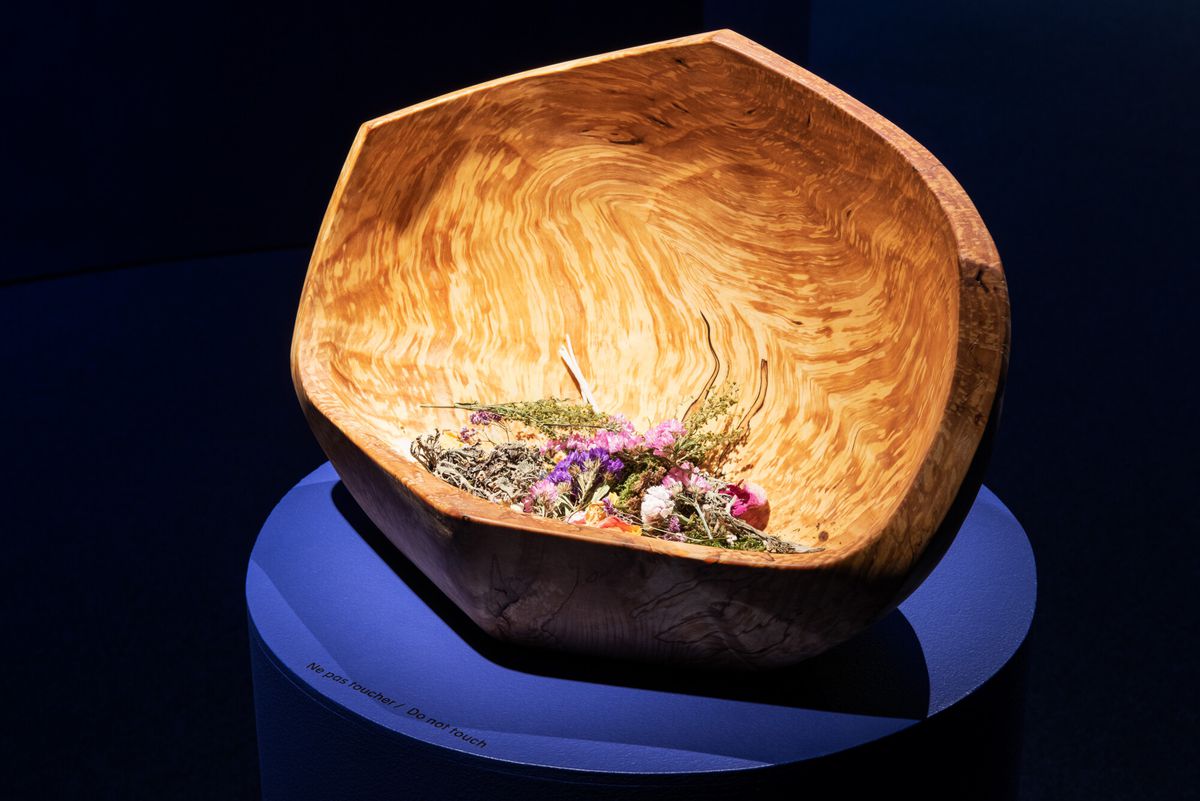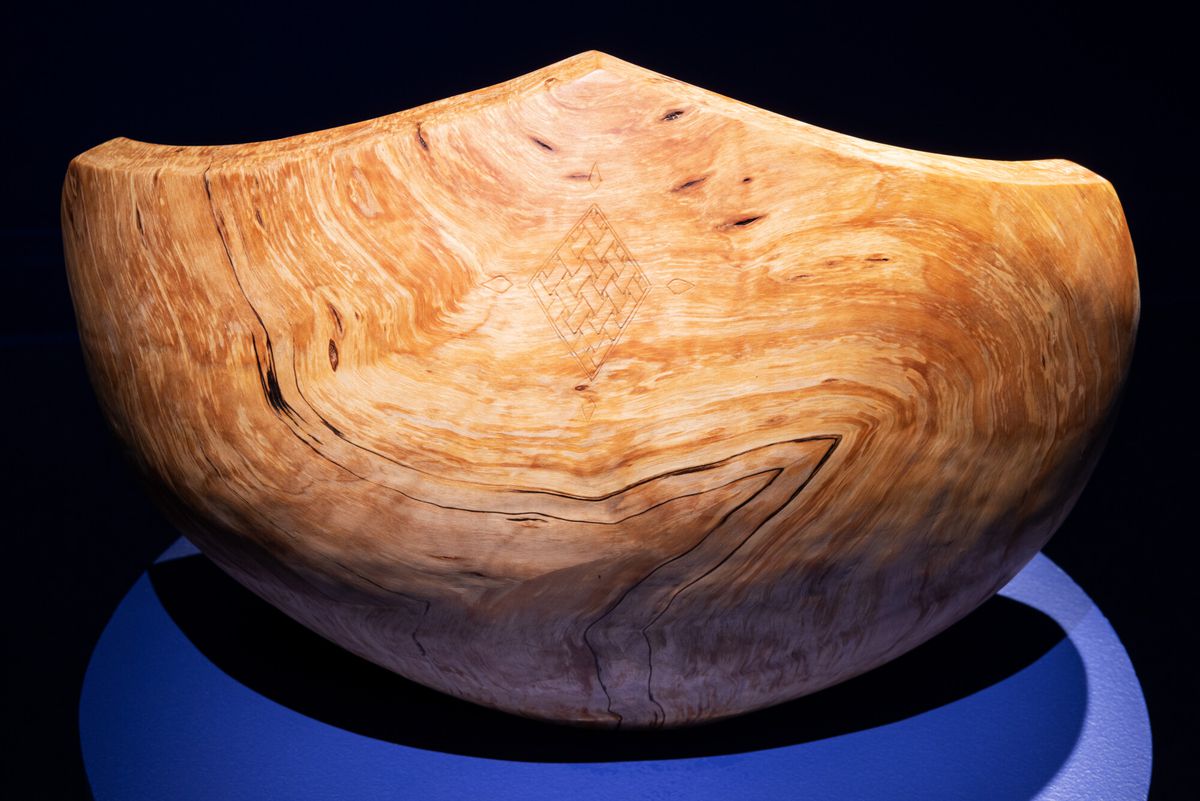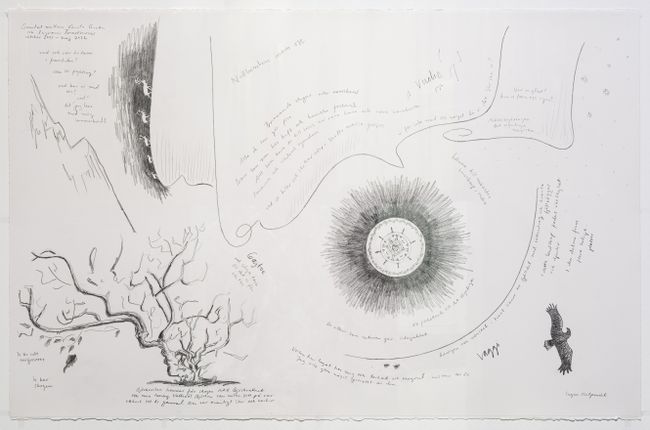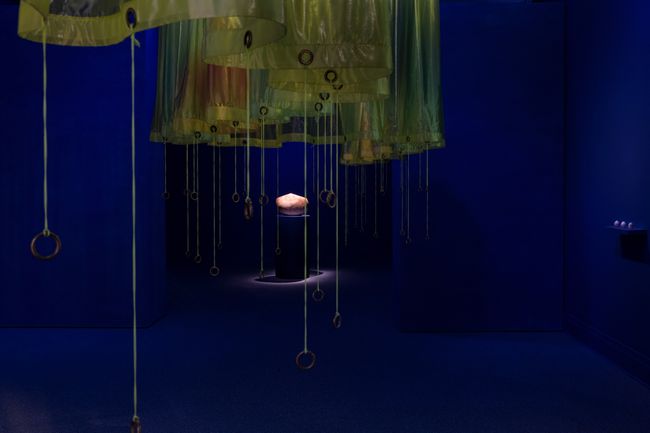Borderless Inventing
Carola Grahn speaks to Rafico Ruiz about craft, collaboration, and Sámi culture
ᐊᖏᕐᕋᒧᑦ / Ruovttu Guvlui / Towards Home was co-curated by Joar Nango, Taqralik Partridge, Jocelyn Piirainen, and Rafico Ruiz, with Ella den Elzen as Curatorial Assistant. The exhibition is currently on view in our Main Galleries and runs until 12 February 2023.
- RR
- I’m really curious to hear about the elements you are contributing to the show through Offernat (Votive Night)—the birch bowl, the textile northern lights, and the brass rings—and how they create a sacred space.
- CG
- One angle to come into this work is of course the collaboration I did with Ingemar Israelsson, and maybe that’s the most important one because it has steered the process. Ingemar is a duojár and he’s about seventy years old. He has a lot of knowledge and he is from similar areas to where my Sámi relatives come from, and he’s also a friend of my father. He’s great.
When we started our collaboration I didn’t know him personally or the way he works, but what was exciting was that when I told him about this project he immediately started to talk about this piece of wood that he had and how special it was. Many years ago—maybe even forty or so—he found this piece of wood and he was like, “This kind of wood, you only find maybe once or twice in a lifetime.” It was this really big birch burl. He said, “I’ve had it laying around for a long time, and I’ve never felt that I had the right occasion to work with it, but I feel like maybe this is it.”
And so he started to work with it, and after a while he found out that it’s not dense enough to hold water like I had originally envisioned, as it might crack. I was a little bit disappointed at the start because adding water to it for me was a way of making this object come alive in an art context. It’s not always so simple to exhibit craft and art seamlessly, in the sense that very easily the craft becomes only something aesthetic and maybe even primitive at times. Adding dripping water to it was a way to make it function as crafts actually do in life; making it come alive. First he said, “I don’t think it’s going to hold water,” but the more we talked he decided, “Actually, it cannot. I don’t want it to.”
I had the feeling that he fell in love with this piece of wood, or that he already had a really, really strong relationship to it. He was just following the form of it and some kind of inner vision of how he wanted it to be, and I had to take a step back and see how it would end up. It was a beautiful way of learning how a duojár often actually works. That process is so dedicated to following the material, and the material decides what it’s going to be in the end.
Conceptually, that was beautiful. The piece still has a bit of a bowl shape, but because it’s this special piece of wood, I thought it would be really nice to have it as an altar. And instead of adding water, adding flowers or leaves or other things every day as an offering to make it alive, but also to make it a ritual for the museum staff to go and replace those things. That is how I often work; a lot of things happen “off-stage,” so I have staff doing things that are not so public. Here hopefully the staff can have this offering, sometimes maybe consciously thinking about something, but also sometimes just doing their work, replacing the flowers. However it’s made it’s going to be a ritual, because it needs to be done so often. And that is the part that I really like about it: that I create a movement within the piece. Putting this duodji—this craft—as an altar makes it special. To have it as a centrepiece is also a gesture of saying this is something very, very important, and then at the same time saying that this knowledge is really important.
- RR
- That’s a really nice overview of what it takes to create a welcoming altar. I’m particularly curious to learn more about the significance of the brass rings that are part of the piece?
- CG
- Many aspects of Sámi religion are perhaps not that present anymore, but I think brass rings are something that has stayed. Brass is part of my gákti, of my traditional Sámi clothing. In our soft duodji the brass rings are still present in different things that we make, bags for example. Originally they were a big deal, and in a way they still are, at least to some people.
In Sámi worldview and storytelling they are often part of myths; I think the most common one is the bear myth, where there would be big ceremonial feasts when hunters came back after shooting a bear. There are stories about how women had to look at the bear through a brass ring in order to subdue the bear’s mystical power. I don’t want to say that the presence of the brass rings has an exact meaning in this piece, but it definitely refers to those stories. The brass rings bring that magic to the piece.
The other part of the work is looking at the future, and I feel the future is so unclear and so scary, so that’s where the dark skies and dark surroundings come in. What can we even say about the future or sovereignty of any people or anything today when the environment is changing, and people are subject to a lack of so many things?
In that sense, culture and beliefs come into play. Adding the altar is referring even stronger to “religion,” but not a specific religion. That’s a question that I want to pose to the audience: what do we believe in in the end? And I have no answer to that, but I get a little bit of relief in thinking of my childhood memories. I come back to those moments where, for example, I really have this strong memory of hearing my footsteps on the snow, it being very, very dark, and then seeing the northern lights. I remember walking with my head back on my way home not one time, but many times. I’m trying to move the audience to that place where everything is a bit grander, like it can be when you’re in darkness or in the forest. This year the northern lights have been visible much further south—at least here in Sweden—than normal. There’s been a lot of it on the news, because the hub is Stockholm and Stockholm is much further south. And suddenly it was like, “Oh, northern lights are visible this year,” as if they had never been before. And so maybe Indigenous futures are coming a little bit closer to common society. I think that’s a nice way of thinking of it.
I have this need for people to stop and think about how we can shape tomorrow—but not in the sense of “I’m this people and I belong to the land.” I’m a bit reluctant to that way of thinking. I’m more drawn to thinking, “what can we learn from heritage and history, and what needs to be remembered because we actually need it?” In Scandinavia, Sámi drums were burned as a way of wiping out our religion in the 1700s. And I come back to this question of what we lack to preserve nature, because we, as civilization, keep failing… Maybe it is the humility of asking the shaman, the stars, or the trees for advice. I think many Sámi people are coming back to being again more aware of saying thank you to a tree when it is being cut. Saying thank you to nature—that’s becoming more important again.
- RR
- Maybe it’s a pragmatic question, but for the Swedish census, do you have something connected to religion or Sámi heritage there, so you can self-identify in that way?
- CG
- No. The Swedish Church was connected to the state until twenty years ago. The Church was so forceful in controlling the Sámi people. Even where my Sámi family is from, the priests were very harsh with us not having Sámi names in the records. When I had my kids, I couldn’t find the Sámi names for my relatives in that record; they’re just Swedish.
- RR
- Yeah, I see what you mean. With this installation and the role it plays in the exhibition, notably relating to the question ‘where do we go from here?’, do you see your first public as a Sámi public, or a broader one?
- CG
- No, I kind of hate that division of people, really. I have a Swedish mom, and I feel uncomfortable when someone tries to pick parts of me. The way questions are often asked is as if when you were brought up Sámi that you could divide what’s Sámi and what’s just northern Swedish culture, and I think it’s a very dangerous way of simplifying reality and what it does to identity and what it does to people. I don’t want to lock anyone out of praying by this altar. It’s for all. I’d rather think of it as everybody becoming Indigenous—not in the appropriation way, but rather teaching customs and ways of living and sharing rather than dividing and saying, “This is not for you, because you’re not Indigenous.”
- RR
- Even in the construction of this question that structures the show, ‘where do we go from here?’, there’s an inclusiveness in the “we” and there’s an inclusiveness in thinking about land as something that is connective.
- CG
- I really think that now with the movement of peoples, with refugees, that’s where we should start thinking “where do we go from here?” Because people are already moving by force. Being forced. And that is due to environmental issues that we should admit we are all part of it whether we wanted it or not. Part of being colonized is that it has changed us. I have a phone now. I do travel with all those resources and I’m very rich in a global context. Thinking of the future, that’s something I have to include in my thinking.
- RR
- I did want to ask you about your relationship to architecture as a field; what sort of relationship you see yourself as having to architecture as it can be redefined as a land-based practice?
- CG
- Before this show, I thought that I was close to architecture because I like to work big, and I also work with artworks outdoors, integrated into new buildings. But because of how the questions for this show were asked, I really got a feeling that there is a difference in how architects and artists go about things. So I was like, “Oh, I’m very much an artist!” But I’m interested in many of the questions that architects are interested in: how do we build a society and how is space part of that?
My experience in general is that within both Sámi and maybe Indigenous cultures in general, there are less borders between different artforms—it’s borderless inventing. It’s actually very practical: hardware stores were/are far away, so you have to come up with a solution yourself. Culturally, we very quickly think, “I can make that myself!” That mentality makes—“Oh yeah, it’s art. I just made an art piece. No big deal. I made this cup yesterday and then today I made this sculpture.” A lot of people are still like that and I think it is a strength.



